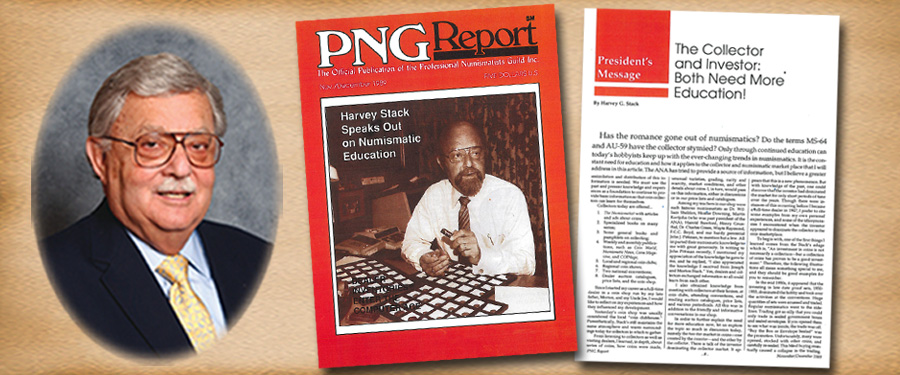
To begin with, one of the first things I learned comes from the Stack’s adage, which is, “An investment in coins is not necessarily a collection — but a collection of coins has proven to be a good investment.” Therefore, the following illustrations all mean something special to me, and they should be good examples for you to remember.
In the mid 1950s, it appeared that the investing in late-date Proof sets, 1950-1955, dominated the hobby and took over the activities at the conventions. Huge quantities of sets were amassed and traded. Regular numismatics went to the sidelines. Trading got so silly that you could only trade in sealed government boxes and sealed envelopes. If you opened them to see what was inside, the trade was off. “Buy the Box or Envelope Sealed” was the promotion. Unfortunately, many were opened, stocked with other coins, and carefully re-sealed. This blind buying eventually caused a collapse in the trading. But the collector survived, with his systematic collecting of coins, which he could see, touch, and personally examine.
In the mid 1960s, rolls and bags became the investor craze — only bank-sealed rolls or bags could be traded. You couldn’t open either if you wanted to trade them. Unscrupulous people acquired bank wrapping machines, used the actual coins as the end coins, and put in circulated (and sometimes washers) in the centers, rewrapped them, and the trade went on. Until one day some were opened, and shortly thereafter the market collapsed.
To give you an idea how the rolls dominated the market in 1964, I remember the ANA convention of that year vividly. We had with us our usual numismatic selection from half cents to $50 gold, but no rolls. A man walked up to my counter and said, “I don’t see any rolls in your case.” I replied, “We didn’t bring any to the show as we specialize primarily in rare U.S. coins.”
“Mr. Stack,” he replied, “you don’t understand rarity. Take the 1950 D nickel. Only 2,300,000 were struck, that means there could be only 58,000 rolls, or 580 bags, and Mr. Stack, you should know that anything of which only 580 exist is rare.” Statistics don’t lie, but the uninformed surely know how to distort statistics. The collector fortunately survived this phenomenon as well.
In 1970, the redemption of silver certificates dominated every coin show. You couldn’t see inside the cases because currency being counted covered them from end to end. The collector survived again.
In 1979 and 1980, silver bullion coins and bullion gold dominated the market. Dealers didn’t have time other than to count and trade the bullion items. With the drop in the bullion market at the end of 1980, the collector once again emerged as the survivor.
Presently we hear of the “slab coin” investor dominating the market. Here again, we must put things into the proper perspective. Of all the 1-1/2 million or so coins slabbed, over 60% are 64 or better. This means that the tens of millions of coins that are extant, grading 63 or less, have not been slabbed, and most never will be. The collector who likes the best he can get and afford is leaving much of the slabbing to the investor who seems to want only the 64-plus coins.
This becomes an interesting phenomenon to observe, especially when investors are also using statistics provided by the services to determine rarity. Consider, if 10,000 1924 average MS-60-61 double eagles are never submitted, does the number slabbed truly give a population count of what is extant in all grades — or is it used solely for the grades examined? The statistics may be new knowledge for the investor to assimilate, but does he know that other coins could and do exist?
Statistics, as you know, are not new to numismatics. First of all, Mint reports quoted in the “Guidebook,” give the number of each denomination struck. This is a basic statistic, but not a helpful guide to determine a population availability count among the various denominations. It is an elementary truth that statistics can be used but too easily abused. Fortunately there are several perceptive researchers who have shown us how statistical facts can be put to work for the general benefit of the hobby.
Dr. Sheldon did a study surveying large cent collections to develop his “Condition Census” for his book published in 1949. With the aid of the information in his book, a new book was published in 1958 as new finds were reported and resulted in a major census change.
David Akers surveyed some 50 years of auction catalogs to bet a relative condition census for his books on U.S. $1 to $20 gold published quite a few years ago. Yet he admits, in his 20th-century gold coin book recently written, previous condition censuses had to be amended because of the more sales that occurred.
Martin Gengerke has done a statistical survey on U.S. paper money by using a computer. This is always being updated.
The “Bust Half Dollar Club” does statistics on rarities of this series, and revised reports are continuously issued to its members.
So, statistics are not new. They are only as good as those who provide the input and how it is used. Learning to interpret statistics should be part of any educational program. We believe the collector will survive the present phenomenon of grading statistics.
(Continued next week)





